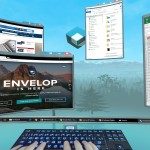Envelop, the virtual reality desktop platform for Windows, has launched as a public beta for anyone with a Vive or Rift to enjoy.
After announcing a $5.5 million Series A investment at the beginning of 2016, followed by a closed beta at the beginning of July, Envelop has now launched as an open beta for anyone to use their HTC Vive or Oculus Rift to turn their Windows computer into a VR desktop environment.
Envelop essentially takes your standard Windows desktop and blows it up into a sphere around you, allowing you to drag your usual windows and programs anywhere around you—as if you had a giant wrap-around monitor. In concept, it’s pretty much exactly what comes to mind for anyone envisioning the future of VR desktop computing.
One particularly cool feature of Envelop is the ability to use a webcam to pipe a live view of your keyboard into the virtual desktop environment, making a huge dent in the can’t-see-my-keyboard-while-wearing-a-headset problem. Users can also change the visuals of the surrounding environment on the fly with the click of a button.
In the future, Envelop VR’s SDK will allow developers to extend existing applications out into the Envelop virtual environment, enabling a wide range of uses like on-the-fly data visualization, 3D product views, or even virtual real-estate tours loaded from a web listing.








